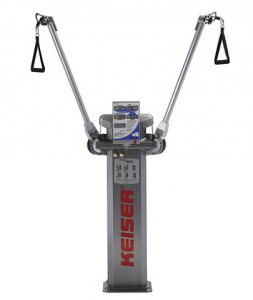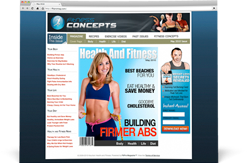Personal Trainer Certification – Why Muscle Power Matters
Posted by Steve Hochman on Thu. Feb. 6th, 2014
Guest Post by Cody Sipe, PhD
Muscle power is an essential element of physical function and a component that declines very rapidly with advancing age. In fact, although many of us are obsessed with muscle strength, studies show that muscle power declines earlier than muscle strength in mature adults and that it declines at a faster rate. Many activities of daily living, such as stair climbing, walking uphill and quick acceleration, rely on adequate power making it a critical component to address in a functional exercise program.
Most of the focus should be on improving lower body power (which is explained in greater detail in the Functional Aging Specialist Certification- a personal trainer certification that focuses on functional training strategies) but upper body power is also important. Even a task as seemingly mundane as opening a heavy door requires sufficient upper body power along with core and lower body stability.

Unfortunately, the traditional “way” of training upper body strength isn’t the best for improving power. Consider the typical seated row on a selectorized machine. For one, since the weight stack moves against gravity performing high-velocity movements are a little tricky and can be somewhat dangerous. When a high speed movement against resistance is initiated a lot of force is generated in order to get the weight stack moving. After the weight stack gets moving then momentum takes over and very little force is needed during the latter half of the movement.
So really high force at the beginning and very little force at the end.
Secondly, there is basically no core requirement because the chest pad on the seated row stabilizes the trunk artificially which does not mimic daily activities. There is no external trunk stabilizer when a person opens a heavy door or starts a lawn mower. Trunk stability must be accomplished through co-activation of the core musculature.
Thirdly, the traditional row is performed bilaterally (using both arms simultaneously). Again, this doesn’t really mimic daily activities which are typically performed unilaterally (one arm). And even if it were performed unilaterally the chest pad would stabilize the trunk anyway eliminating most of the core demands.
In addition, what we typically consider “power lifting” (moves such as snatches, cleans and jerks) is not typically appropriate for the older client. Now I will be the first to admit (and I teach people) that the older clientele is very diverse and there may be some that could do these traditional movements. However, there are very, very few that could. So when we talk about training for muscle power we do not mean traditional power lifting.
If we really want to perform upper body power rowing movements to prepare for activities of daily living then they need to be performed:
· Unilaterally (to create sagittal and transverse plane forces)
· In a stable stance position (to create ground reaction forces)
· With no external trunk stabilizers (to activate core musculature)
· With equipment that minimizes or eliminates momentum
An exercise that I use often with clients and we teach in the Functional Aging Specialist Certification is the 1-arm standing row in a semi-lunge position. Our preference is to use the Keiser Performance Trainer, the Keiser Functional Trainer or resistance tubing. Not everyone is going to have access to Keiser equipment but it is ideal for performing power movements because it uses pneumatic (compressed air) resistance.

But this isn’t the old school pneumatic equipment that pushes air out of a hole in a cylinder increases resistance as movement speed increases (because it is trying to push air out of the hole at a faster rate). Keiser is highly technological and designed so that the force profile curve stays the same no matter what speed the person moves. We use Keiser in our two training facilities because of the advantages it offers with an older clientele.
However, resistance tubing is also able to remove momentum from the equation and provide a smooth resistance curve. Anchor the tubing to a door or other stable object at the same height that you would if using a cable column. As the tubing is stretched the resistance increases. This may seem counter-productive when the point is to move at a high speed but the resistance only increases to a small degree.
Power movements are typically performed as quickly as possible on the concentric part of the movement and slow and controlled on the eccentric part of the movement with a slight pause at full contraction. So during the Power Row the “fast” part is performed on the pull and the “slow and controlled” part is performed as the arm is extended.
Variations include modifications to the stance position, the angle of the pull and adding dynamic movement such as lunging.
- Cody Sipe, PhD
Posted in Boot Camp Business, Boot Camp Marketing, Boot Camp Strategies, Fitness Business, How To Start a Fitness Boot Camp Business by |

